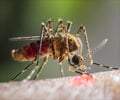Highlights:
- New test diagnoses Zika infection avoiding false positives from Dengue and other related viruses
- The paper-based is highly accurate and provides the result in just 20 minutes
- The test could offer an easy-to-use, cost effective and portable diagnostic in countries where Zika is highly prevalent
"It's important to have a single test that can differentiate between the four serotypes of Dengue and Zika, because they co-circulate. They're spread by the same mosquito," says Kimberly Hamad-Schifferli, an associate professor of engineering at the University of Massachusetts at Boston, a visiting scientist in MIT's Department of Mechanical Engineering.
New Diagnostic Test for Zika Infection
Diagnosing Zika virus is a challenging task because currently available tests are based on antibodies that interact with a viral protein called NS1 (nonstructural protein 1), which is found in the bloodstream of infected patients.Zika, Dengue, West Nile and Yellow fever viruses are from the same family known as flaviviruses. These viruses have similar versions of NS1 and can produce a false positive when diagnosing Zika infection.
In an effort to create a precise diagnostic test, the research team set out to find antibodies that would interact with NS1 protein produced by the Zika virus, as well as antibodies specific to NS1 from each of the four different strains of the Dengue virus.
The research team conducted a study on mice exposed to Zika and Dengue viruses. Then they screened the resulting antibodies in pairs against every flavivirus’ version of NS1 protein. MIT team found pairs of antibodies that react only with one version of NS1 and not any of the others.
"We knew by informatics analysis that if we looked enough, and we teased out the repertoire of the B cells of these animals, we would eventually find those antibodies. We were able to tease out the very few antibodies within the repertoire that would give you uniqueness in the detection," said Irene Bosch, research scientist at the Institute for Medical Engineering and Science (IMES).
How to Detect Zika Infection using Paper-based Test?
The team used the pairs of antibodies to create five separate tests, one for each virus. Strips of paper were coated with one antibody from each pair, while the other antibody was attached to gold nanoparticles.For the test, patient’s blood sample is added to a solution of nanoparticles. Then the paper strip is dipped into the solution. If NS1 protein is present in the blood sample, it attaches to the antibodies on the paper strip as well as to the nanoparticle-bound antibodies. A colored spot appears on the strip within 20 minutes.
This paper-based test requires five test strips per sample to test for each virus. The MIT research team worked with scientists around the world to test the new device on patient samples to confirm that it can accurately detect Zika virus from related viruses.
The results of the new test were comparable to those obtained by polymerase chain reaction (PCR) tests. PCR test which detects viral RNA in the bloodstream is not widely used in areas where Zika virus is found because they require trained personnel and lab equipment that are not available everywhere.
"By already screening this group of antibodies that we have against all these antigens we have, like West Nile, we already know how well they react. So that's information we could use in the future to develop additional tests that can be used to detect other emerging viruses," said Lee Gehrke, professor in MIT’s IMES.
The new test would allow them to quickly develop diagnostic tests for other related viruses that might emerge in the future. Currently, the research team is working on to develop a diagnostic test that would test for all five viruses with one strip.
The research team is also working on a diagnostic test for the emerging Powassan virus, which is carried by a tick that spreads Lyme disease. Powassan, which is found in the northeastern United States and the Great Lakes region, causes a severe form of encephalitis.
The findings of the study appear Science Translational Medicine.
Zika Virus
Zika virus is a mosquito-borne flavivirus which is transmitted by Aedes mosquitoes. It can also be transmitted through sexual intercourse. Zika virus is a cause of microcephaly and Guillain-Barré syndrome. Some of the symptoms of Zika virus include mild fever, skin rash, headache, conjunctivitis, muscle and joint pain.There is no specific treatment for Zika. People infected with Zika should get plenty of rest, drink enough fluids and treat pain and fever with common medicines. Protection against mosquito bites is one of the key measures to prevent Zika virus.
- Wear clothes that cover the body as much as possible
- Use window screens, mosquito nets and insect repellent
- Avoid traveling to Zika affected areas
Reference:
- Irene Bosch et al., Rapid Antigen Tests for Dengue Virus Serotypes and Zika Virus in Patient Serum. Science Translational Medicine, (2017). DOI:10.1126/scitranslmed.aan1589
Source-Medindia













